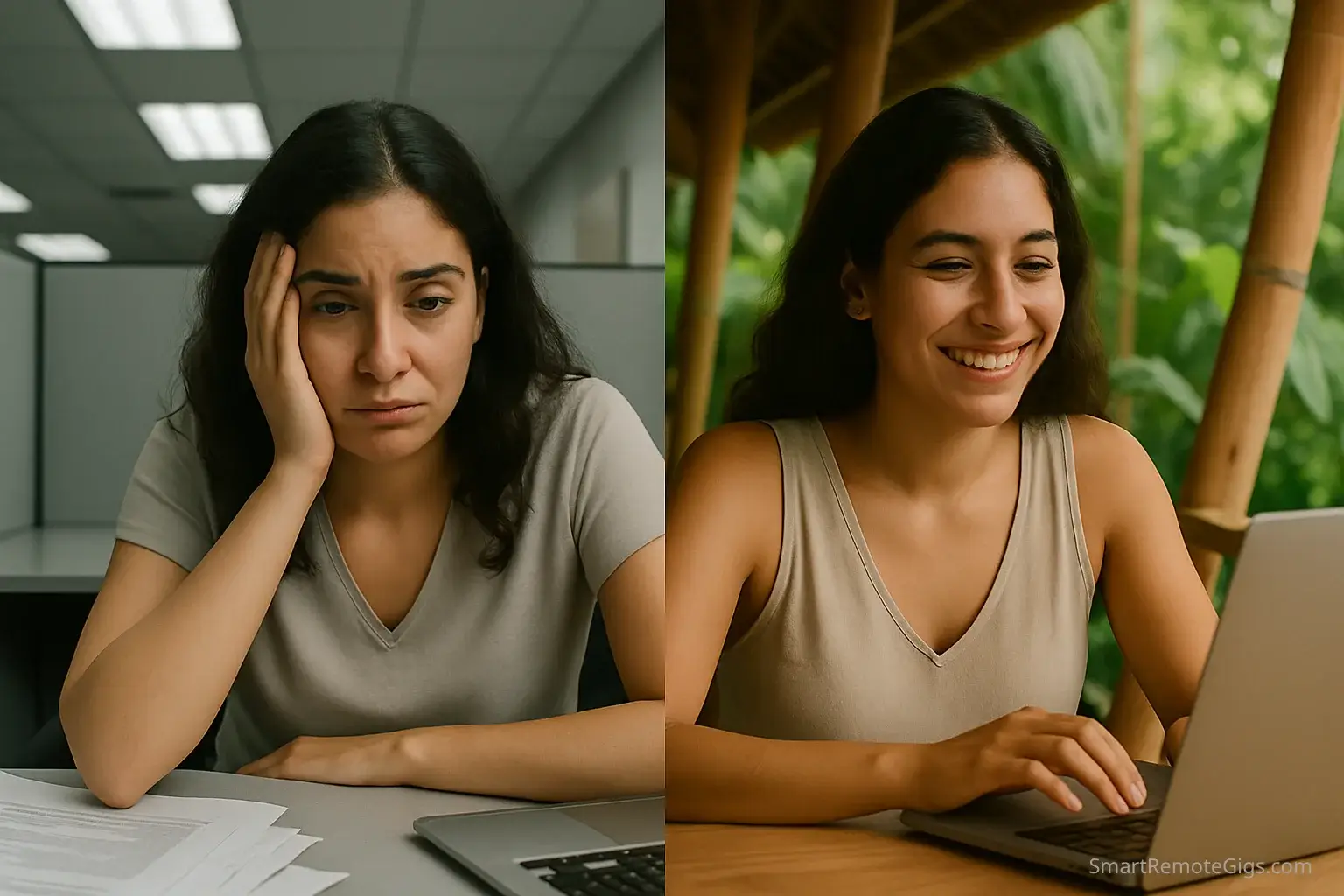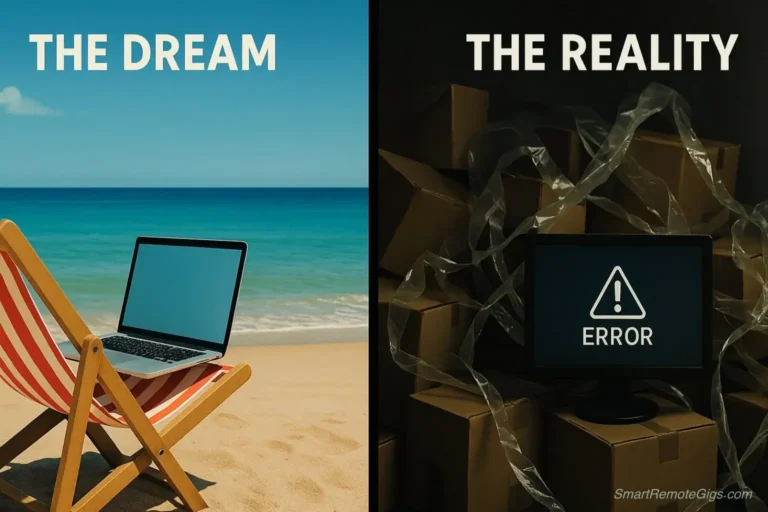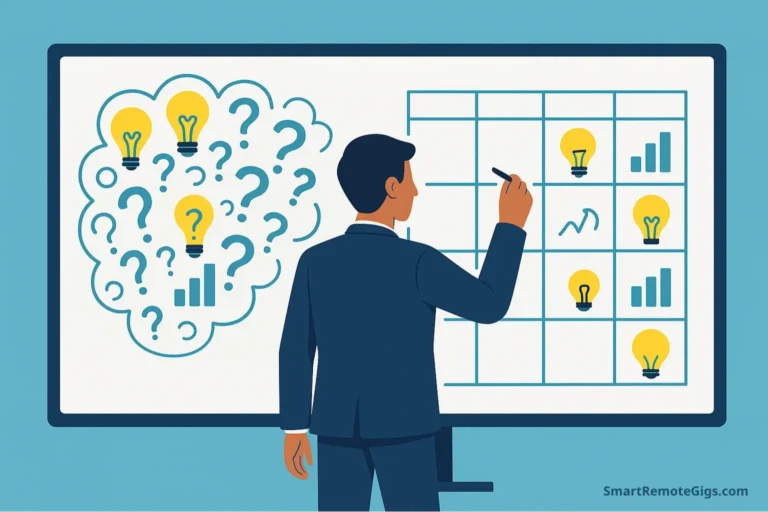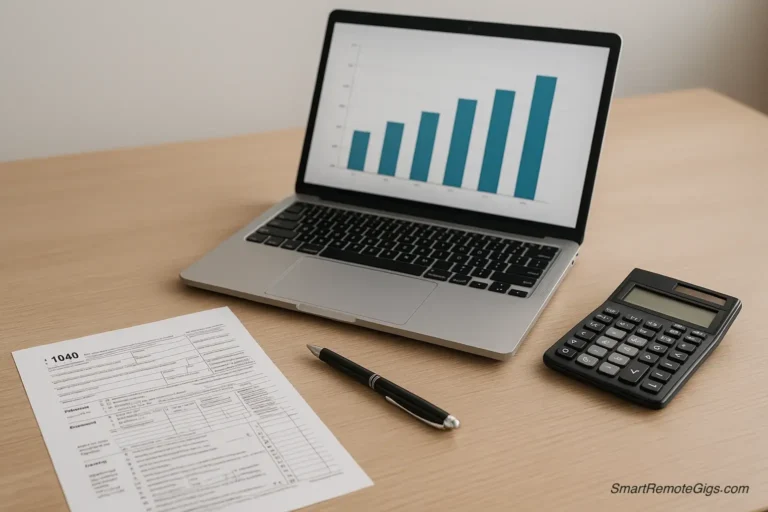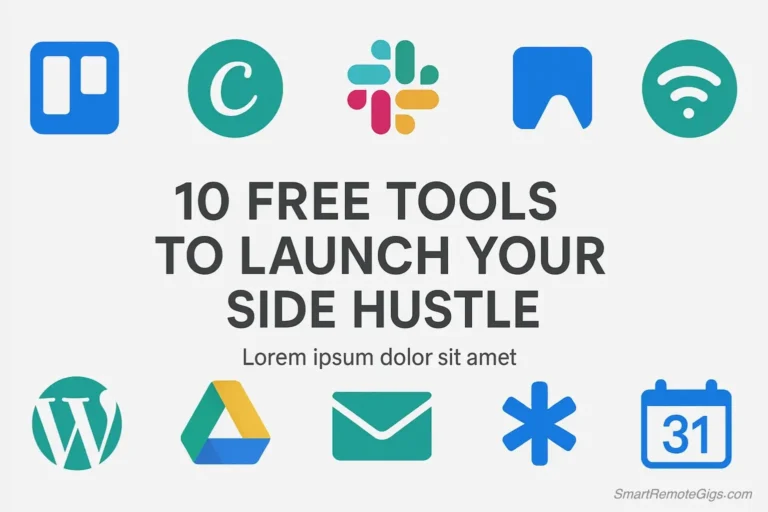Six months ago, Sarah Martinez was trapped in a gray cubicle in downtown Chicago, watching the same pigeons land on her office window ledge every morning at 9:17 AM. Today, she’s typing this update from a bamboo café in Canggu, Bali, with the Indian Ocean as her backdrop and a fresh coconut as her coffee replacement.
This isn’t another “I quit my job and became a nomad overnight” fantasy story. This is a real case study digital nomad transformation—messy, strategic, and completely achievable. Sarah’s journey from corporate America to Bali beaches proves that with the right plan, anyone can make the office worker to remote transition in just six months.
We documented every step of Sarah’s transformation, from her first Google search about remote work to her first client call from a Balinese coworking space. Her story illustrates exactly how The 2026 Digital Nomad Guide principles work in real life—complete with budget breakdowns, timeline mishaps, and honest reflections on what actually worked.
Sarah’s Take: “Everyone told me I was crazy to leave a stable marketing job for ‘some nomad fantasy.’ But looking back, the craziest thing would have been staying another year in that cubicle, knowing I had a way out.”
– Sarah Martinez, Digital Marketing Consultant, 6 months in Bali
If you’ve been dreaming about your own escape but wondering if it’s actually possible, Sarah’s how to become a nomad story will show you exactly what it takes—and prove that it’s more achievable than you think.
The ‘Why’: The Catalyst for Change

Sarah’s story begins like so many others: with a breaking point disguised as an ordinary Tuesday.
“I was sitting in my fourth meeting of the day about meetings we needed to schedule,” Sarah recalls, laughing. “My manager was explaining why we needed a committee to discuss our new committee structure. I literally looked around the conference room and thought, ‘I’m 28 years old. Is this it?'”
But Sarah’s catalyst wasn’t just corporate frustration—it was a combination of factors that created the perfect storm for change:
The Financial Reality Check: After five years as a marketing coordinator, Sarah was earning $52,000 annually but barely saving money. Chicago rent consumed 40% of her income, and she calculated that she’d need 15 years to afford a down payment on a modest condo.
The Remote Work Revelation: During the 2020-2022 remote work period, Sarah discovered she was actually more productive at home. “I realized 90% of my job could be done from anywhere with WiFi,” she explains. “But my company was pushing hard for everyone to return to the office full-time.”
The Travel Awakening: A two-week vacation to Thailand in early 2023 opened Sarah’s eyes to the cost-of-living possibilities. “I spent $800 total for two weeks, including accommodation, food, and activities. That was less than one month of my Chicago rent,” she remembers.
The Breaking Point: The final straw came during a performance review where Sarah’s manager criticized her for “lack of enthusiasm” about returning to office full-time. “I had just presented a campaign that generated $200K in new revenue, but my ‘enthusiasm’ about sitting in traffic for two hours daily was questioned. That night, I started researching remote work options.”
Sarah’s motivation wasn’t about Instagram-worthy sunsets—it was about financial freedom, work-life alignment, and escaping a system that felt fundamentally broken.
The 6-Month Timeline: From Dream to Reality
Sarah’s transformation followed a methodical approach inspired by The 2026 Digital Nomad Guide. Here’s exactly how she executed her move to bali timeline:
Month 1-2: Securing Remote Work & Saving

The Remote Work Strategy: Sarah knew her current company wouldn’t approve permanent remote work, so she focused on building freelance skills while still employed.
“I started small,” Sarah explains. “I offered to help friends with their social media marketing for free, just to build a portfolio. Then I took on small projects through Upwork during evenings and weekends.”
Month 1 Actions:
- Researched high-demand digital marketing skills
- Created profiles on Upwork, Fiverr, and LinkedIn
- Completed three free projects for portfolio building
- Started networking in digital marketing Facebook groups
- Began tracking all expenses to identify savings opportunities
Month 2 Breakthrough:
- Landed first paid freelance client ($500 project)
- Completed Google Ads and Facebook Ads certifications
- Connected with three potential ongoing clients
- Increased savings rate from 10% to 25% of income
Financial Progress:
- Starting emergency fund: $2,400
- Month 2 emergency fund: $4,100
- Freelance income: $800
“The hardest part was working 50+ hours per week between my day job and building freelance income,” Sarah admits. “But seeing that first $500 payment hit my account made it real—I could actually earn money from anywhere.”
Month 3-4: The Downsizing & Logistics

The Great Purge: Month 3 marked Sarah’s transition from planning to action—starting with the most emotionally challenging part: downsizing her entire life.
“‘The hardest part was selling my car,’ Sarah recalls. ‘It felt like I was selling my old identity.'”
But the downsizing process was also liberating. “I realized I owned so much stuff I never used. Selling everything felt like shedding weight I didn’t know I was carrying.”
Month 3 Actions:
- Listed car for sale ($8,500 net proceeds)
- Began selling furniture and electronics
- Researched Bali visa requirements and cost of living
- Applied for additional freelance projects
- Started Indonesian language learning (Duolingo + YouTube)
Month 4 Logistics Sprint:
- Secured three ongoing freelance clients ($2,800 monthly income)
- Sold remaining possessions except essentials
- Researched health insurance options for overseas coverage
- Began visa application process for Indonesia
- Found temporary accommodation in Canggu through nomad Facebook groups
Financial Progress:
- Emergency fund: $7,800
- Asset sales proceeds: $12,300
- Monthly freelance income: $2,800
- Total available funds: $20,100
The Emotional Rollercoaster: “Month 4 was when reality hit,” Sarah reflects. “I had panic attacks about leaving my stable job. My parents thought I was having a quarter-life crisis. But I’d come too far to turn back.”
Month 5-6: Booking, Packing & Liftoff
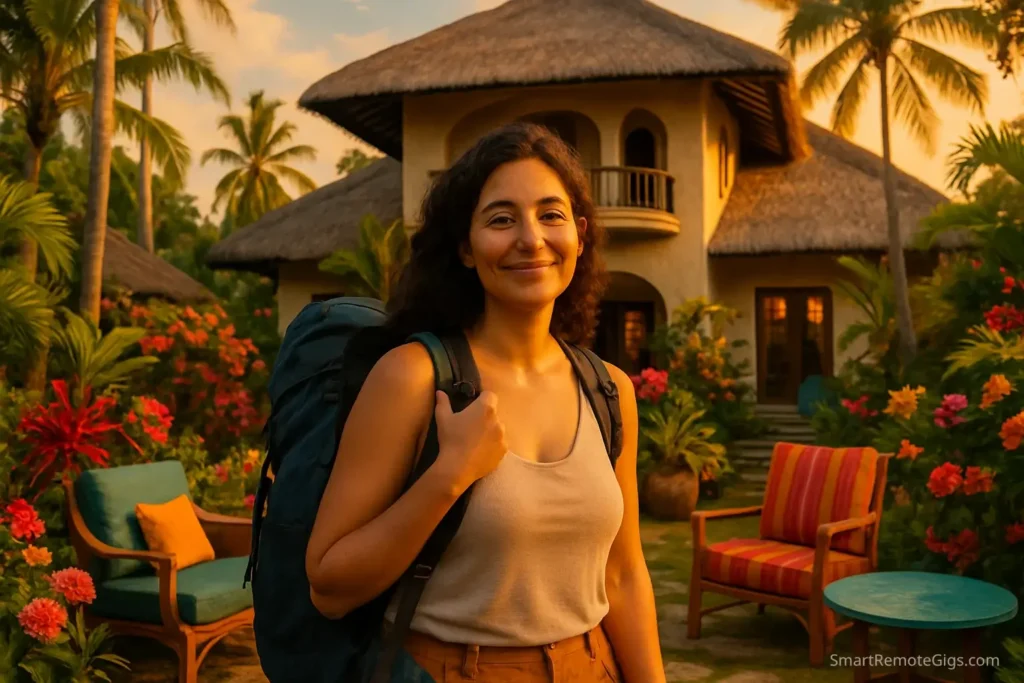
The Point of No Return: Month 5 began with Sarah submitting her resignation letter—a moment she describes as “terrifying and exhilarating simultaneously.”
“I gave four weeks’ notice, which my manager tried to convince me was ‘career suicide,'” Sarah laughs. “But I’d already replaced my full-time salary with freelance income. The math worked.”
Month 5 Actions:
- Submitted resignation with four weeks’ notice
- Booked one-way ticket to Bali ($890)
- Secured two months of accommodation in Canggu
- Purchased comprehensive travel health insurance
- Completed visa application (30-day tourist visa for initial entry)
Month 6 Final Sprint:
- Worked final weeks at corporate job
- Finalized client contracts and payment schedules
- Completed nomad gear purchases (laptop, camera, travel insurance)
- Set up international banking with Charles Schwab
- Packed life into two suitcases and a backpack
The Launch: Sarah’s last day at her corporate job was a Friday. The following Tuesday, she was on a plane to Bali.
“Walking out of that office for the last time felt surreal,” she remembers. “My coworkers threw a goodbye party, but half of them were asking for my freelance rate cards. The irony wasn’t lost on me.”
Final Financial Status:
- Emergency fund: $9,500
- Monthly freelance income: $3,400
- First-month Bali budget: $1,200 allocated
Sarah’s Bali Start-Up Budget: A Real-World Breakdown
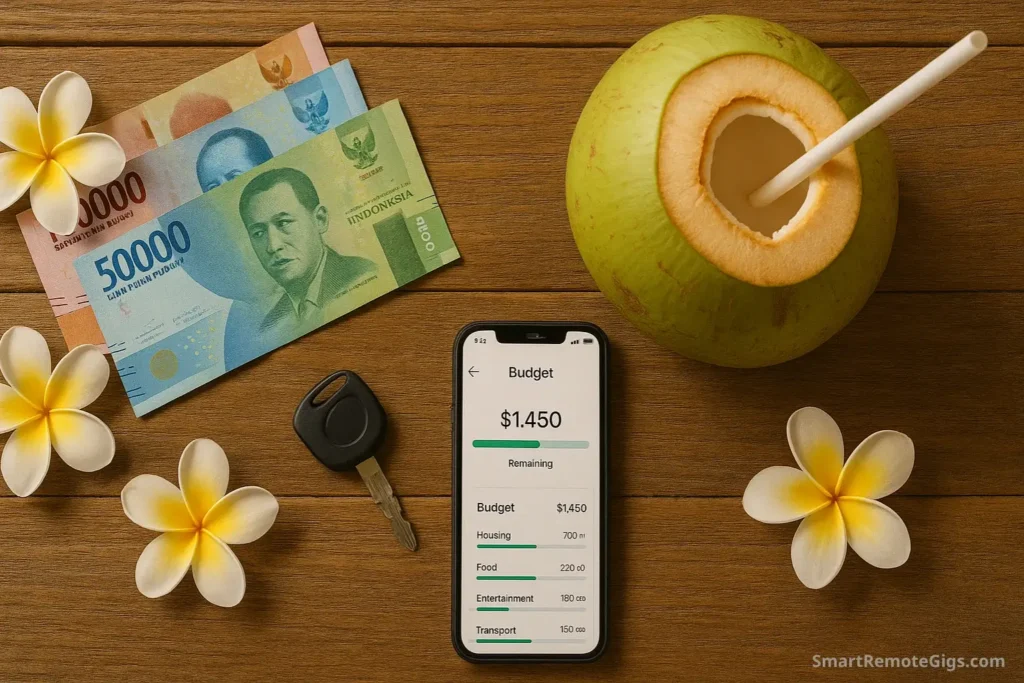
Here’s Sarah’s actual digital nomad budget example for her first three months in Bali, proving that the lifestyle is more affordable than most people assume:
| Expense Category | Month 1 | Month 2 | Month 3 | Notes |
|---|---|---|---|---|
| Accommodation | $420 | $380 | $450 | Private room in shared villa, Canggu |
| Food & Dining | $180 | $220 | $200 | Mix of local warungs and cafés |
| Transportation | $85 | $60 | $70 | Scooter rental + occasional Grab rides |
| Coworking | $65 | $65 | $65 | Dojo Bali monthly membership |
| Internet/Phone | $25 | $20 | $20 | Local SIM card + backup WiFi |
| Health/Fitness | $45 | $60 | $55 | Yoga classes, gym day passes |
| Entertainment | $120 | $140 | $110 | Beach clubs, cultural activities |
| Miscellaneous | $80 | $90 | $70 | Laundry, supplies, unexpected costs |
| Visa/Legal | $35 | $60 | $0 | Tourist visa + extension |
| TOTAL MONTHLY | $1,055 | $1,095 | $1,040 | Average: $1,063 |
Key Budget Insights:
- Accommodation savings: 75% less than Chicago rent
- Food costs: High-quality meals for $2-5 at local warungs
- Transportation: Scooter rental more cost-effective than car ownership
- Coworking: Essential for reliable internet and community
- Hidden costs: Visa extensions, health checkups, equipment replacement
“My biggest surprise was how affordable eating out could be,” Sarah notes. “In Chicago, restaurant meals cost $15-25. In Bali, I get incredible Indonesian food for $2-3. I actually eat out more now and spend less on food overall.”
Income vs. Expenses:
- Monthly freelance income: $3,400
- Monthly expenses: $1,063
- Monthly savings: $2,337 (69% savings rate!)
This budget proves that Bali offers exceptional value for nomads, allowing Sarah to save more money while dramatically improving her quality of life.
3 Key Lessons Learned from Sarah’s Journey
After six months of nomadic life, Sarah has gained insights that only come from actually making the leap. Here are her most valuable lessons for aspiring nomads:
Lesson 1: Start Before You’re Ready
“I waited for the ‘perfect’ moment for years,” Sarah admits. “Perfect freelance income, perfect savings amount, perfect plan. But perfect never comes. I finally realized that 80% ready with momentum beats 100% ready with analysis paralysis.”
Sarah’s advice: Set a non-negotiable launch date and work backward. “Having a booked flight ticket creates urgency that planning alone never will. Fear of wasting money on a ticket motivated me more than any vision board.”
Practical application: If you’re earning any freelance income and have 3-6 months of expenses saved, you’re ready enough to start. The skills you need will develop faster when your income depends on them.
Lesson 2: Community Matters More Than Location
“I chose Bali for the beaches and low costs,” Sarah explains. “But what made it incredible was the nomad community. I’ve learned more about business in six months here than in five years of corporate life.”
Sarah’s Canggu network includes:
- A mentor who scaled her copywriting business to six figures
- Accountability partners for productivity and goal-setting
- Technical advisors for website and systems optimization
- Social connections that prevent the loneliness many nomads experience
Sarah’s advice: “Join nomad communities online before you travel. I connected with Bali nomads through Facebook groups while still in Chicago. Having familiar faces when I arrived made the transition infinitely easier.”
Practical application: Research nomad hubs with strong communities in your field. The relationships you build will be more valuable than the Instagram photos you take.
Lesson 3: Systems Beat Motivation
“Motivation got me started, but systems keep me going,” Sarah reflects. “The freedom of nomad life is incredible, but it requires more structure than corporate life, not less.”
Sarah’s essential systems:
- Client communication: Set office hours in client time zones
- Financial tracking: Weekly expense and income reviews
- Workspace routine: Same coworking space, same daily schedule
- Health maintenance: Consistent exercise and meal planning
- Social connection: Weekly video calls with family and Chicago friends
“The paradox of nomad life is that ultimate freedom requires ultimate discipline,” Sarah observes. “Without systems, the freedom becomes chaos pretty quickly.”
Practical application: Build location-independent routines before you travel. Practice working from cafes, managing multiple time zones, and maintaining productivity without office structure.
The Meta-Lesson: “The biggest lesson is that becoming a nomad isn’t about changing who you are—it’s about becoming more of who you already are, just in better locations with more freedom,” Sarah concludes.
Her journey illustrates that the office worker to remote transformation isn’t about completely reinventing yourself. It’s about leveraging your existing skills in a location-independent way while building the systems and mindset that make freedom sustainable.
Your Turn: Making Sarah’s Success Replicable
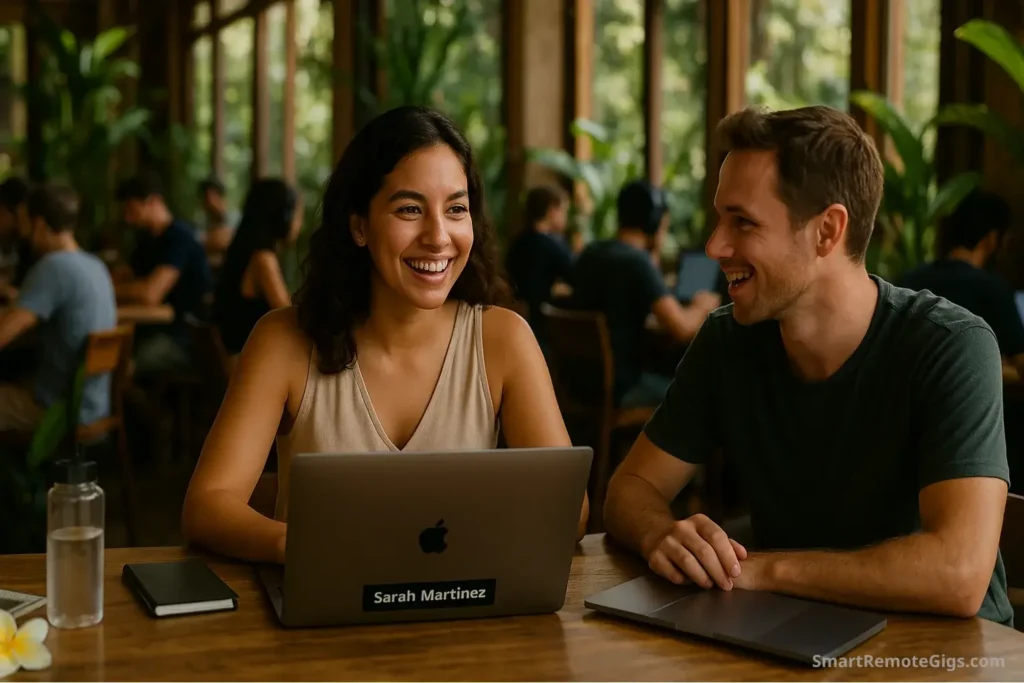
Sarah’s story proves that the case study digital nomad transformation is achievable with the right approach, but it’s not a copy-paste template. Her specific circumstances—marketing skills, savings discipline, and single status—created advantages that won’t apply to everyone.
However, her framework is universally applicable:
Phase 1: Skill Building (Months 1-2)
- Identify your location-independent skills
- Build freelance income while employed
- Create financial runway through aggressive saving
Phase 2: Transition Planning (Months 3-4)
- Downsize possessions systematically
- Research destination logistics thoroughly
- Build remote income to replacement levels
Phase 3: Launch Execution (Months 5-6)
- Secure legal and logistical requirements
- Transition to full-time remote work
- Execute travel plans with proper preparation
For the complete framework that guided Sarah’s transformation, including detailed worksheets and templates, check out The 2026 Digital Nomad Guide: Your Roadmap to Freedom.
Ready to start your own transformation? Sarah’s journey began with a single decision to take action. Six months later, she’s living proof that with clear planning and consistent execution, the nomad lifestyle isn’t just a dream—it’s a systematic process anyone can follow.
The only question left is: what’s your catalyst for change?
Sarah’s Final Advice: “Stop waiting for permission from your boss, your family, or society to live the life you want. I spent three years thinking about becoming a nomad and six months actually becoming one. The thinking years were the wasted ones.”
– Sarah Martinez, currently building her digital marketing agency from a beach café in Bali
Your six-month countdown starts now. What will your story be?

